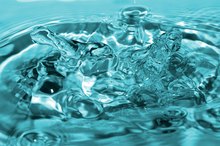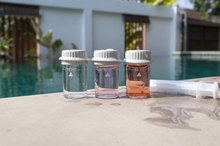What pH in Water Is Too High for Human Consumption
In chemistry, the pH scale measures how acidic or alkaline something is. Generally speaking, the pH value of water does not directly affect human health, although it can have an indirect effect by corroding plumbing, which leaches metals into the water. Only when water is contaminated with another substance can the pH reach an especially high or low level, but even then, the pH value alone doesn't determine whether water is safe to drink.
Hydrogen
The initials "pH" stand for "potential of hydrogen"; the H is capitalized because it's the chemical symbol for hydrogen. In scientific terms, the pH scale measures the relative concentrations of hydrogen ions and hydroxyl ions in a substance. When hydrogen ions outnumber hydroxyl ions, the substance is acidic; when hydroxyl ions have the edge, the substance is alkaline.
The pH Scale
What Is the pH of D.I. water?
Learn More
The pH scale runs from 0 to 14. A pH of 7 is "neutral," meaning the two types of ions are in balance, so the substance is neither acidic nor alkaline. Values below 7 are acidic, with 0 being the most acidic. Values above 7 are alkaline, with 14 being the most alkaline. Battery acid has a pH of about 0. Liquid drain cleaner has a pH of about 14. Distilled, filtered water has a pH of about 7. Each unit within the scale represents a tenfold increase in acidity or alkalinity.
Water
Water found in nature will generally have a pH between 6.5 and 8.5, depending on geological and atmospheric conditions. According to the University of Massachusetts and the Water Systems Council, the pH of drinking water is not a health issue. Water's pH value can get neither high enough nor low enough to pose a hazard. However, if the water is contaminated, the pH may be significantly higher or lower. But it's the nature of the contaminant not the pH value that determines whether the water is unsafe to drink. Lemon juice, for example, is extremely acidic, with a pH of about 2, while milk of magnesia is quite alkaline, with a pH between 10 and 11 -- yet both are safe to consume.
Aesthetic Effects
Effects of Sodium Hydroxide in a Swimming Pool
Learn More
The Environmental Protection Agency classifies a pH value above 8.5 or below 6.5 as a "secondary contaminant" in drinking water. However, the effects of high or low pH, the EPA states, are mainly "aesthetic" -- that is, related to taste and odor. Water with a low pH can have a metallic, bitter or sour taste; water with a high pH can have a baking-soda taste. In addition, pH outside the EPA-recommended range can damage plumbing. Acidic water can corrode pipes; alkaline water can form scaly deposits.
Related Articles
References
Writer Bio
Cam Merritt is a writer and editor specializing in business, personal finance and home design. He has contributed to USA Today, The Des Moines Register and Better Homes and Gardens"publications. Merritt has a journalism degree from Drake University and is pursuing an MBA from the University of Iowa.









